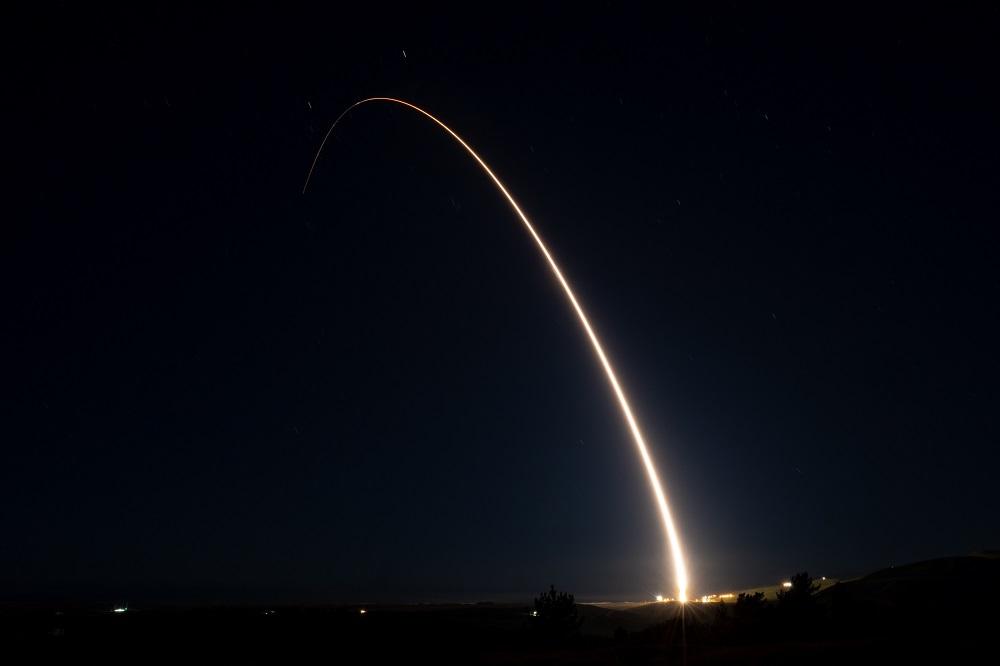A team of U.S. Air Force Global Strike Command Airmen launched an unarmed Minuteman III intercontinental ballistic missile equipped with a test reentry vehicle on Feb. 9 from Vandenberg Space Force Base, California. This test launch is part of routine and periodic activities intended to demonstrate that this U.S. nuclear deterrent is safe, secure, reliable, and effective to deter twenty-first century threats and reassure U.S. allies. Such tests have occurred over 300 times before, and this test is not the result of current world events. The ICBM’s reentry vehicle traveled approximately 4,200 miles to the Kwajalein Atoll in the Marshall Islands. These test launches verify the accuracy and reliability of the ICBM weapon system and provides valuable data to ensure a continued safe, secure and effective nuclear deterrent. Airmen from the 91st Missile Wing at Minot Air Force Base, North Dakota, were selected for the task force to support the test launch.
“This launch showcases the redundancy and reliability of our strategic deterrence systems while sending a visible message of assurance to allies. This multilateral team reflects the precision and professionalism of our command, and our joint partners,” said Col. Christopher Cruise, 377th Test and Evaluation Group commander.
“A test launch displays the heart of our deterrence mission on the world’s stage, assuring our nation and its allies that our weapons are capable and our Airmen are ready and willing to defend peace across the globe at a moment’s notice,” said Gen. Thomas A. Bussiere, commander of Air Force Global Strike Command.
“This test launch is a culmination of months of preparation and collaboration across multiple Air Forces agencies,” said Maj. Martin Escarzaga, task force commander. “The Airmen who perform this mission of strategic deterrence are the best our nation has to offer. They work 365 days a year to maintain, support, operate, and secure this vital component of our nuclear triad.”
The missile bases within Air Fore Global Strike Command have crew members standing alert 24 hours a day, year-round, overseeing the nation’s ICBM alert forces. The ICBM community, including the Department of Defense, the Department of Energy, and U.S. Strategic Command, uses data collected from test launches for continuing force development evaluation. The ICBM test launch program demonstrates the operational capability of the Minuteman III and ensures the U.S.’s ability to maintain a strong, credible nuclear deterrent as a key element of U.S. national security and the security of U.S. allies and partners. Air Force Global Strike Command is a major command with headquarters at Barksdale Air Force Base, Louisiana, in the Shreveport-Bossier City community. The command overseas the nation’s three intercontinental ballistic missile wings, the Air Force’s entire bomber force, to include B-52 Stratofortress, B-1B Lancer and B-2 Spirit wings, the Long Range Strike Bomber program, Air Force Nuclear Command, Control and Communications systems, and operational and maintenance support to organizations within the nuclear enterprise.
The LGM-30 Minuteman is an American land-based intercontinental ballistic missile (ICBM) in service with the Air Force Global Strike Command. As of 2023, the LGM-30G Minuteman III version is the only land-based ICBM in service in the United States and represents the land leg of the U.S. nuclear triad, along with the Trident submarine-launched ballistic missile (SLBM) and nuclear weapons carried by long-range strategic bombers. The Minuteman entered service in 1962 as a deterrence weapon that could hit Soviet cities with a second strike and countervalue counterattack if the U.S. was attacked. By the 1970s, 1,000 Minuteman missiles were deployed. This force has shrunk to 400 Minuteman III missiles as of September 2017, deployed in missile silos around Malmstrom AFB, Montana; Minot AFB, North Dakota; and Francis E. Warren AFB, WyoThe LGM-35 Sentinel, also known as the Ground Based Strategic Deterrent (GBSD), will replace the Minuteman III ICBM with an initial capability of 2029. Until full capability is achieved in the mid-2030s, the Air Force is committed to ensuring Minuteman III remains a viable deterrent.
















